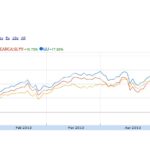The days of consistent 4% annual withdrawals from a retirement fund are long gone. A paper from Morningstar rejects the idea that anyone can pull 4% per year from their retirement balance with any confidence. Â Overconfidence is common, but not prudent.
Here’s the skinny:
- Low rates crush income potential – At the time the 4% withdrawal rule came into being, interest rates on government bonds were well over 4% for intermediate maturities. Today’s retirement investor won’t find 4% on any US government bond as even the long bond yields just 3.1%.  While mortgage rates are still at record lows, that’s little solace for those renting or unable to refi.
- New normal is emerging – The earliest years of retirement define the later years. Early drawdowns lead to an underfunded retirement as one ages. Stock markets are unlikely to provide their historical returns given that money is cheap, and cheap money is eventually priced into all asset classes.
- Probability of success dwindling – A 60/40 fixed-income and equity portfolio would have a 50% probability of success over 30 years with a 4% annual draw. To get to a 90% level of confidence, one would have to pull as little as 2.8% per year from their portfolio.
Living on 2.8% per year
Can you live on a 2.8% draw on your retirement balances? Morningstar highlights the reality of a low-rate environment, noting that savers would need 42.9% more savings at 2.8% than they would at a 4% draw from their retirement balances. That’s unwelcome news for anyone looking to retire today after modest single-digit real returns from equities in the past decade.
So where should investors turn?
Future retirees should wake up to a new reality:
- Equity holdings should generate some income – The equity portion of your retirement savings should generate some income to displace the low rates in fixed-income investments.
- Equities shouldn’t be priced as income investments – Part of the problem with the current batch of high-yield ETFs is that their high-yields leave them to be highly correlated to the bond market. Investors should seek dividend-paying equities that aren’t as correlated to interest rates.
Utilities, REITs, and mortgage REITs all offer high yields, but they are, in essence, equities that trade like bonds.
Here are two equity ETFs offering yield without significant rate-risk:
- Dividend growth funds – Among the best of the breed in dividend growth ETFs is Vanguard’s Dividend Appreciation ETF (VIG). This dividend fund looks for companies that can fundamentally carry a higher dividend rate in the future, and which have consistently increased their dividends in the past. What makes this fund most attractive is that it does not carry a substantial portion of the fund in capital-intensive businesses like utilities or REITs, which are prone to serious interest rate risk. In a previous article, I noted that the Vanguard ETF has managed to find compounded annual growth in dividends of 7.2% per year even during a recession, making it a strong choice for savers.
- Current dividend funds – Investors should seek some form of current yields. The Vanguard High Dividend Yield Index ETF (VYM) is an excellent play in this space, seeing as it managed a 12-month yield of just under 3% without heavy industrial and utility weightings as an alternative, the iShares Dow Jones Select Dividend Index Fund (DVY). The iShares offering has 31% of its assets in utility stocks, followed by another 15% in industrials. Vanguard’s fund has fewer ties to capital-intensive industries, with consumer defensive coming in at its biggest sector weighting at 19%.
Investors who want to maximize the amount they can draw safely from their retirement savings are in good hands with dividend ETFs. However, one should be sure to carefully analyze the stocks in the mix. High-yielding sectors are attractive for any saver, but one must remember that if interest rates rise, capital-intensive businesses that make up most high-yield ETFs will be the first to take a nosedive at the same time a retiree’s fixed-income exposure takes the same dip.
Income from equity holdings shouldn’t be strongly correlated to bond performance. These two Vanguard ETFs help investors inexpensively achieve a goal of income with less correlation to their fixed-income holdings.
Disclosure: No position in any tickers mentioned here.










{ 0 comments… add one now }